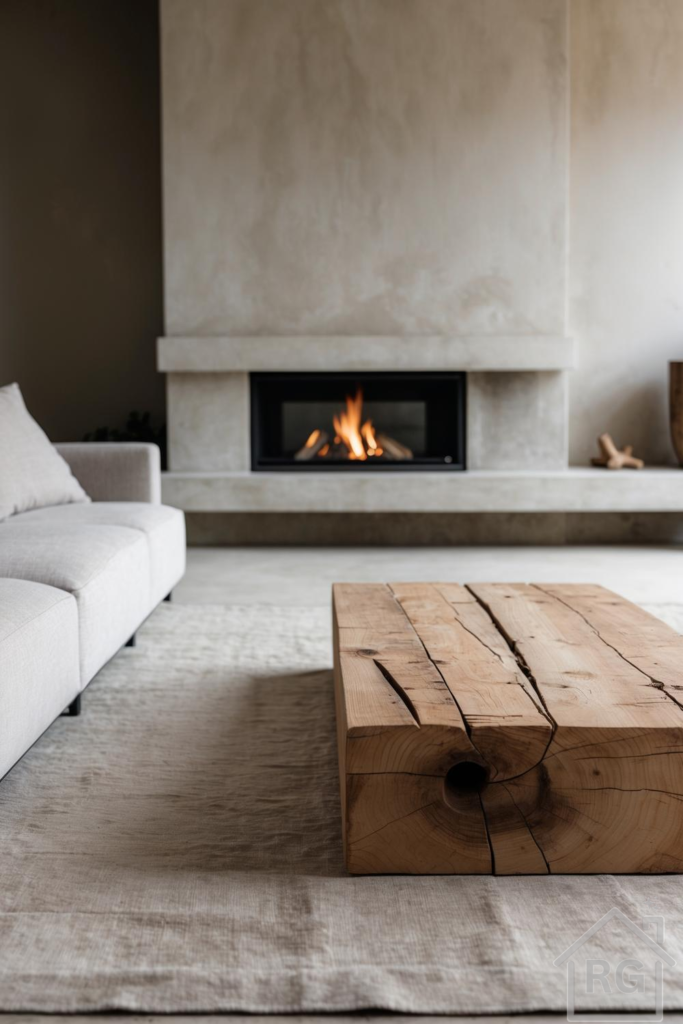
Embracing Warm Minimalism: A Study in Texture and Tone
Minimalism often evokes images of stark white spaces, but a growing trend, ‘Warm Minimalism,’ proves that simplicity can coexist beautifully with comfort and soul. This approach, perfectly exemplified by the featured living room, blends clean lines and uncluttered surfaces with natural textures and a soothing, earthy palette. It’s about creating a space that feels both modern and inviting, sophisticated yet deeply calming. Let’s delve into how this harmonious balance is achieved.
The Foundation: Architectural Elements and Finishes
The cornerstone of this design is the striking fireplace surround. Crafted from smooth, light-toned concrete or a similar plaster finish, it establishes a strong, monolithic presence. Its clean lines and unadorned surface are quintessentially minimalist. Unlike cold, industrial concrete, the finish here possesses a subtle warmth and variation in tone, likely achieved through techniques like Tadelakt or microcement, preventing it from feeling sterile. This tactile quality invites touch and adds depth. The seamless integration extends to the hearth and potentially the flooring, creating a unified, grounding effect.
The walls continue this theme, likely finished in a similar plaster or a matte paint in a coordinating warm beige or greige hue. This continuity envelops the space in a soft, cohesive shell, allowing the key furniture pieces and textures to take center stage.
The Soul: Natural Textures and Materials
Warm minimalism thrives on the interplay of textures. Here, the undeniable star is the coffee table. Constructed from thick, reclaimed wooden beams, it introduces a powerful element of rustic nature. The wood’s prominent grain, deep cracks, knots, and rough-hewn edges provide a dramatic counterpoint to the smoothness of the fireplace. This contrast is key – it prevents the minimalism from becoming flat or one-dimensional. The table isn’t just furniture; it’s a piece of natural sculpture, grounding the space and adding historical character.
Further textural richness comes from the soft furnishings. The large area rug features a subtle, low-pile weave, likely a natural fiber like wool, jute, or a blend, in a complementary neutral shade. It defines the seating area, adds underfoot comfort, and softens the transition between the floor and the furniture. The sofa, upholstered in a light grey or off-white woven fabric, contributes another layer of tactile softness. Its simple, modern silhouette maintains the minimalist aesthetic, while the fabric choice ensures it feels comfortable and approachable.
Achieving the Warm Minimalist Look
Inspired by this serene space? Here’s how to incorporate elements of warm minimalism into your own home:
- Master the Palette: Stick to a restrained palette of warm neutrals. Think beige, greige, taupe, ivory, soft grey, and muted browns. Use variations in tone rather than introducing multiple distinct colors. Accents should be subtle – perhaps the warm glow of firelight, the deep tone of wood, or the black of metal details (like the fireplace insert).
- Prioritize Texture: This is non-negotiable. Contrast smooth finishes (plaster, concrete, matte paint) with natural, tactile materials. Incorporate wood (especially reclaimed or rustic), stone, linen, wool, boucle, jute, and ceramics. Texture adds depth, interest, and that crucial feeling of warmth.
- Choose Furniture Wisely: Opt for pieces with clean lines and simple forms, but don’t sacrifice comfort. Look for quality materials. A statement piece, like the chunky wood coffee table, can anchor the room. Ensure furniture is appropriately scaled to the space – clutter is the enemy of minimalism.
- Integrate Natural Elements: Wood is central, but consider other natural touches like stone accessories, dried branches (like the small piece on the hearth), or even indoor plants (though used sparingly to maintain the uncluttered feel).
- Focus on Lighting: Natural light is ideal. Keep window treatments simple. For artificial light, opt for warm sources. Consider integrated lighting or minimalist fixtures. The fireplace itself provides both literal and visual warmth.
- Edit Ruthlessly: Minimalism requires careful curation. Avoid excessive decoration or clutter. Every object should serve a purpose or contribute significantly to the aesthetic. Keep surfaces clear and storage solutions discreet.
The Fireplace: A Modern Hearth
The linear gas fireplace is a perfect fit for this aesthetic. Its horizontal orientation complements modern design sensibilities. Encased in black metal, it provides a clean, graphic contrast to the light concrete surround. The realistic flames offer dynamic movement and a warm, inviting glow, becoming a focal point without overwhelming the space’s tranquility. It’s a functional element that doubles as a source of ambiance and visual warmth, essential in a minimalist setting.
The Enduring Appeal
Warm minimalism resonates because it offers a refuge from the visual noise of the outside world. It creates spaces that feel grounded, peaceful, and intrinsically connected to nature through its use of materials and textures. By balancing simplicity with tactile richness and a soothing palette, this style achieves a timeless elegance that promotes relaxation and well-being. It’s not about deprivation, but about intentional choices that lead to a richer, more serene living experience.
This living room is a masterclass in achieving that balance. The smooth, architectural concrete provides the minimalist framework, while the rustic wood table injects soul and nature. Soft textiles ensure comfort, and the flickering fire adds life and warmth, proving that minimalism can be profoundly inviting.
